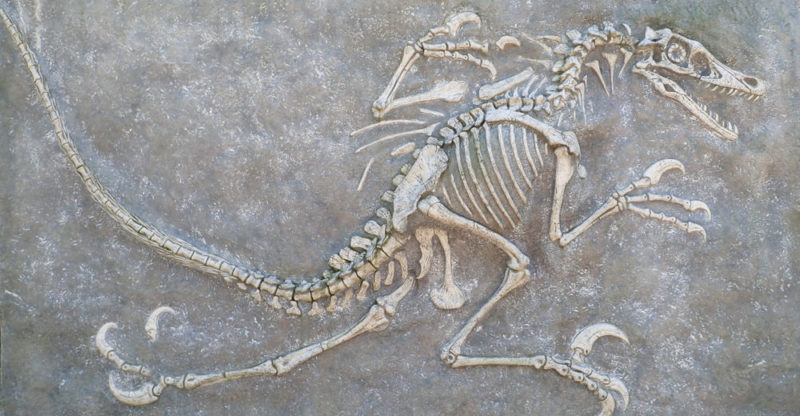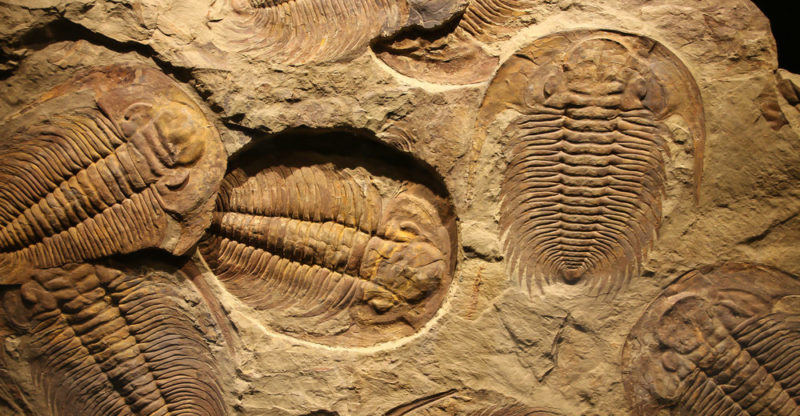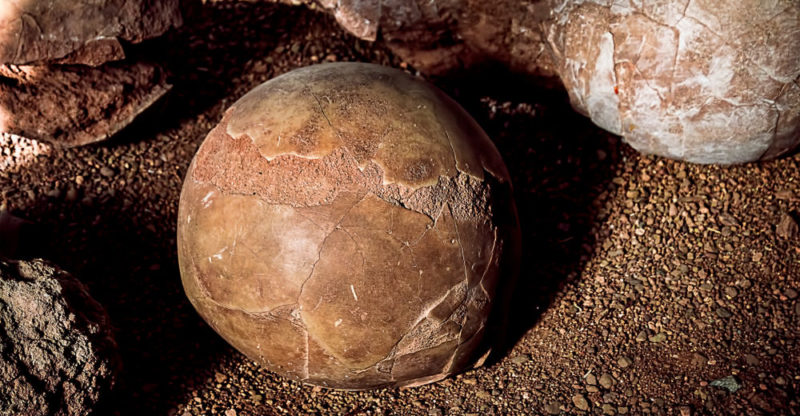We explain what fossils are, how they are formed and the types that exist. Also, what are its general characteristics and importance.
What are fossils?
Fossils are the remains of animals and plants more than 10,000 years old , which are preserved in sedimentary rocks, in amber or in ice. In most cases, they are living beings already extinct and fossils of the complete organism are not usually found, but its skeleton, horns, teeth or footprints.
Not all dead or extinct organisms become fossils. In addition, there are different types of fossilization , which are complex processes that only occur when certain chemical characteristics occur that allow the body or part of it to be preserved. Such is the case of permineralization, preservation or compression.
Fossils can be: macrofossils, when they are large (such as a dinosaur fossil) , or microfossils, when they can only be appreciated by microscopes (such as unicellular fossil organisms), and they are of great importance because they allow us to know the characteristics and the environment of living beings that inhabited the planet in other geological eras.
The science that studies fossils is called paleontology and one of the specialties within this discipline is taphonomy, which studies fossilization processes. Some fossils found throughout history made it possible to study organisms such as dinosaurs , primates, and communities of bacteria .
Guide fossils

The guide fossils, also called director fossils, are those remains of organisms that inhabited the Earth in a specific geological period and that allow us to know information about the rocky stratum in which they were found and to understand the geological process of the planet.
Their characteristics are:
- They must be able to be found in a certain geographic territory and abundantly.
- They must have a certain narrow temporal distribution, that is, they must arise in a certain historical period.
- They must have fossilized more than 10,000 years ago.
- In general, they are species that evolved rapidly and then became extinct in a short period of time.
Fossilization process

Fossilization is a process that does not usually occur frequently because, after the death of an organism, what commonly happens is that it begins to decompose and then begins the process of putrefaction. In exceptional cases and, especially due to diverse environmental conditions such as the appearance of lava, swamp or other phenomena, fossilization can occur.
The fossilization process is very slow and there are different types . One of the most representative is permineralization, a process that begins when the remains of an organism are covered with sediment, which protects them from inclement weather and the passage of oxygen . It is important to mention that only the hard parts of the body such as teeth, bones and shells tend to fossilize, and the soft parts disintegrate. Once the soft parts have been removed, the minerals present in the sediment occupy these voids and allow fossilization.
There are also so-called fossil traces , which are the records or marks left by an animal still alive, such as footprints or trails. The study of these footprints is essential for paleontology since it allows us to know characteristics and information of the beings that inhabited planet Earth.
In other cases, fossilization of the entire organism can occur , when it is kept under ice or is trapped in amber (plant resin that fossilizes and can trap small organisms such as insects or spiders).
Fossil finds

Paleontology works in different parts of the world collecting fossil remains that allow us to know and discover some truths about life on Earth. The set of fossils found is called the "fossil record" and most of these pieces are exhibited in museums throughout the world.
Fossils are usually found in sedimentary rock beds and some of the areas of the world where fossils were found are Messel (in Germany ), the Great Rift Valley (in Africa ), the Liaoning sites (in China ), the park dinosaur province (in Canada), the Patagonia area (in southern South America ), among many others.
Among the most prominent fossil finds are:
- Lucy . It is a hominid skeleton , more than 3.2 million years old, that was found in 1974 in Ethiopia, Africa. It was a being that moved bipedally and fossils of more than 50 bones were found.
- Ardi . It is a skeleton of a female and is the oldest hominid find. Remains of the skull, feet, ankles and hands were found in the Afar desert in Ethiopia, Africa.
- Megalosaurus . It was the first dinosaur to be named and was discovered in the 18th century. It lived during the Jurassic period in present-day European territory and was a bipedal and predatory species.
- Iguanodon . It was the second dinosaur to be named and the first remains of this species were found in 1822. It inhabited Europe and was a herbivorous dinosaur.
- Diplodocus . It was a dinosaur that lived during the Jurassic era in the current territory of North America . The first remains were discovered in 1877 and it was a large species with four legs.
- Tyrannosaurus Rex . It was a carnivorous and bipedal dinosaur that inhabited the current territory of North America during the Cretaceous period . The first fossil was discovered at the beginning of the 20th century and there is a large number of discovered remains of this species.
- Patagotitan mayorum . It was a dinosaur that lived during the Cretaceous period in the current territory of South America. It was discovered in 2014 and is the largest dinosaur known to date. It had four legs and was herbivorous.
- Archeopteryx . It was a species with wings and plumage discovered in 1861 in what is now Europe. It lived during the Jurassic period and its discovery was a landmark because it marked a relationship between dinosaurs and modern birds .
- Yuka . It is the name given to a baby mammuthus (a large animal similar to the elephant ) found in Siberia in a perfect state of conservation as a result of ice.
Types of fossilization

The main fossilization processes are:
- Permineralization . It is the fossilization process in which minerals are precipitated in the pores or holes of shells, bones or tissues, which allows the conservation of the structure of the animal or plant . These minerals then petrify.
- Natural molds . It is the process that occurs when the shape or structure of an organism is settled on a rock. In this case, the organism itself is not fossilized, but rather an impression, so a complete study of the specimen cannot be made, and these molds are then usually filled with other substances. It is a type of fossilization that can be seen in seashells.
- Preservation . It is the process in which the remains of an organism are preserved almost entirely as they are covered with ice or amber. In many cases, both the hard parts and the soft tissues of the animal are preserved, so it is possible to study the specimen in greater depth.
- Compression . It is the process that occurs when the organism is settled on a soft bottom, such as sand, and then it is covered by another layer of sediment.
Types of fossils
Different criteria can be used to distinguish the different types of fossils found throughout history.
According to the part of the body or trace of the living being that is fossilized, they can be:
- Fossil bodies . They are the remains of a living being (usually bones, teeth or shells) that went through a fossilization process and are found a long time later.
- Gastrolitos . They are stones that certain animals, especially birds, ingest to aid digestion and that are found inside the digestive tract of the fossilized animal.
- Coprolites . They are the animal excrement that became fossilized and that allows studying the eating behaviors of the individual.
- Icnofossils. They are the fossilized traces that remain of an organism, such as footprints, footprints, eggs, burrows or nests. This type of fossil allows the study of the behavior of living beings that inhabited the Earth in other periods.
- Microfossil . It is the fossil that can only be observed through an instrument, such as a microscope.
- Macrofossil . It is the fossil that has a medium or large size and can be observed directly without the use of an observation instrument .
Importance of fossils
 Fossils are one of the main sources of knowledge for obtaining information about life on planet Earth during other eras. Thanks to them, it was possible to reveal the existence of extinct plant and animal species and it was possible to learn about their behavior, way of life and territorial distribution. In addition, they provided information about the climate and the ecosystem in which each living being found lived.
Fossils are one of the main sources of knowledge for obtaining information about life on planet Earth during other eras. Thanks to them, it was possible to reveal the existence of extinct plant and animal species and it was possible to learn about their behavior, way of life and territorial distribution. In addition, they provided information about the climate and the ecosystem in which each living being found lived.Paleontology is the science that, over the centuries, was in charge of studying fossils and, based on the information that the guide fossils provided, was able to establish a certain chronological order in the evolution of the planet's fauna and flora and obtain geological information on the characteristics of the Earth over the years. Many of these discoveries revealed the existence of a single supercontinent on the planet.
In addition, fossils provide information that allows us to deduce the environmental circumstances that caused the extinction of the organisms found. Thus, it is believed that some of the species found could have become extinct due to periods of intense rain , tornadoes or hurricane force winds, volcanic eruptions or periods of cooling or global warming.
The above content published at Collaborative Research Group is for informational and educational purposes only and has been developed by referring reliable sources and recommendations from technology experts. We do not have any contact with official entities nor do we intend to replace the information that they emit.
Passionate about understanding and contributing to a world that does not stop changing. New forms of Work, Sustainability and Technology. For many years he has worked as a creative for large international companies. He has a Ph.D. in information technology and he has been doing quantitative research in the interdisciplinary areas of information systems, cyber security, data analytics and artificial intelligence. He continue to look for creative solutions through technology to help companies to be more humane and sustainable..
Leave a reply
Your email address will not be published. Required fields are marked *Recent post

Sport: What Is It, Types, Risks, Features, Characteristics and Examples

Dogs: Emergence, Features, Characteristics, Feeding and Breeds

Story: Definition, Elements, Structure, Features and Characteristics

